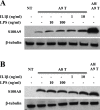Human S100A9 protein is stabilized by inflammatory stimuli via the formation of proteolytically-resistant homodimers
- PMID: 23626736
- PMCID: PMC3633927
- DOI: 10.1371/journal.pone.0061832
Human S100A9 protein is stabilized by inflammatory stimuli via the formation of proteolytically-resistant homodimers
Abstract
S100A8 and S100A9 are Ca(2+)-binding proteins that are associated with acute and chronic inflammation and cancer. They form predominantly heterodimers even if there are data supporting homodimer formation. We investigated the stability of the heterodimer in myeloid and S100A8/S100A9 over-expressing COS cells. In both cases, S100A8 and S100A9 proteins were not completely degraded even 48 hrs after blocking protein synthesis. In contrast, in single transfected cells, S100A8 protein was completely degraded after 24 h, while S100A9 was completely unstable. However, S100A9 protein expression was rescued upon S100A8 co-expression or inhibition of proteasomal activity. Furthermore, S100A9, but not S100A8, could be stabilized by LPS, IL-1β and TNFα treatment. Interestingly, stimulation of S100A9-transfected COS cells with proteasomal inhibitor or IL-1β lead to the formation of protease resistant S100A9 homodimers. In summary, our data indicated that S100A9 protein is extremely unstable but can be rescued upon co-expression with S100A8 protein or inflammatory stimuli, via proteolytically resistant homodimer formation. The formation of S100A9 homodimers by this mechanism may constitute an amplification step during an inflammatory reaction.
Conflict of interest statement
Figures







Similar articles
-
S100A8/A9 mRNA induction in an ex vivo model of endotoxin tolerance: roles of IL-10 and IFNγ.PLoS One. 2014 Jun 23;9(6):e100909. doi: 10.1371/journal.pone.0100909. eCollection 2014. PLoS One. 2014. PMID: 24956170 Free PMC article.
-
FGF-2, IL-1beta and TGF-beta regulate fibroblast expression of S100A8.FEBS J. 2005 Jun;272(11):2811-27. doi: 10.1111/j.1742-4658.2005.04703.x. FEBS J. 2005. PMID: 15943814
-
The hetero-oligomeric complex of the S100A8/S100A9 protein is extremely protease resistant.FEBS Lett. 2007 Oct 30;581(26):5127-30. doi: 10.1016/j.febslet.2007.09.060. Epub 2007 Oct 8. FEBS Lett. 2007. PMID: 17936757
-
S100A8/A9 in Inflammation.Front Immunol. 2018 Jun 11;9:1298. doi: 10.3389/fimmu.2018.01298. eCollection 2018. Front Immunol. 2018. PMID: 29942307 Free PMC article. Review.
-
Inflammation-associated S100 proteins: new mechanisms that regulate function.Amino Acids. 2011 Oct;41(4):821-42. doi: 10.1007/s00726-010-0528-0. Epub 2010 Mar 6. Amino Acids. 2011. PMID: 20213444 Review.
Cited by
-
Target-selective protein S-nitrosylation by sequence motif recognition.Cell. 2014 Oct 23;159(3):623-34. doi: 10.1016/j.cell.2014.09.032. Epub 2014 Oct 16. Cell. 2014. PMID: 25417112 Free PMC article.
-
Inflammatory Changes in Bone Marrow Microenvironment Associated with Declining B Lymphopoiesis.J Immunol. 2017 May 1;198(9):3471-3479. doi: 10.4049/jimmunol.1601643. Epub 2017 Mar 20. J Immunol. 2017. PMID: 28320833 Free PMC article.
-
Computational Deciphering of the Role of S100A8 and S100A9 Proteins and Their Changes in the Structure Assembly Influences Their Interaction with TLR4, RAGE, and CD36.Protein J. 2024 Apr;43(2):243-258. doi: 10.1007/s10930-024-10186-0. Epub 2024 Mar 2. Protein J. 2024. PMID: 38431537
-
Changing expression system alters oligomerization and proinflammatory activity of recombinant human S100A9.bioRxiv [Preprint]. 2024 Aug 14:2024.08.14.608001. doi: 10.1101/2024.08.14.608001. bioRxiv. 2024. PMID: 39185185 Free PMC article. Preprint.
-
Blocking S100A9-signaling is detrimental to the initiation of anti-tumor immunity.Front Immunol. 2024 Oct 21;15:1479502. doi: 10.3389/fimmu.2024.1479502. eCollection 2024. Front Immunol. 2024. PMID: 39497822 Free PMC article.
References
-
- Schafer BW, Heizmann CW (1996) The S100 family of EF-hand calcium-binding proteins: functions and pathology. Trends Biochem. Sci 21: 134–140. - PubMed
-
- Marenholz I, Heizmann CW, Fritz G (2004) S100 proteins in mouse and man: from evolution to function and pathology (including an update of the nomenclature). Biochem Biophys Res Commun 322: 1111–1122. - PubMed
-
- Salama I, Malone PS, Mihaimeed F, Jones JL (2008) A review of the S100 proteins in cancer. Eur J Surg Oncol 34: 357–364. - PubMed
-
- Foell D, Frosch M, Sorg C, Roth J (2004) Phagocyte-specific calcium-binding S100 proteins as clinical laboratory markers of inflammation. Clin Chim Acta 344: 37–51. - PubMed
Publication types
MeSH terms
Substances
LinkOut - more resources
Full Text Sources
Other Literature Sources
Miscellaneous

